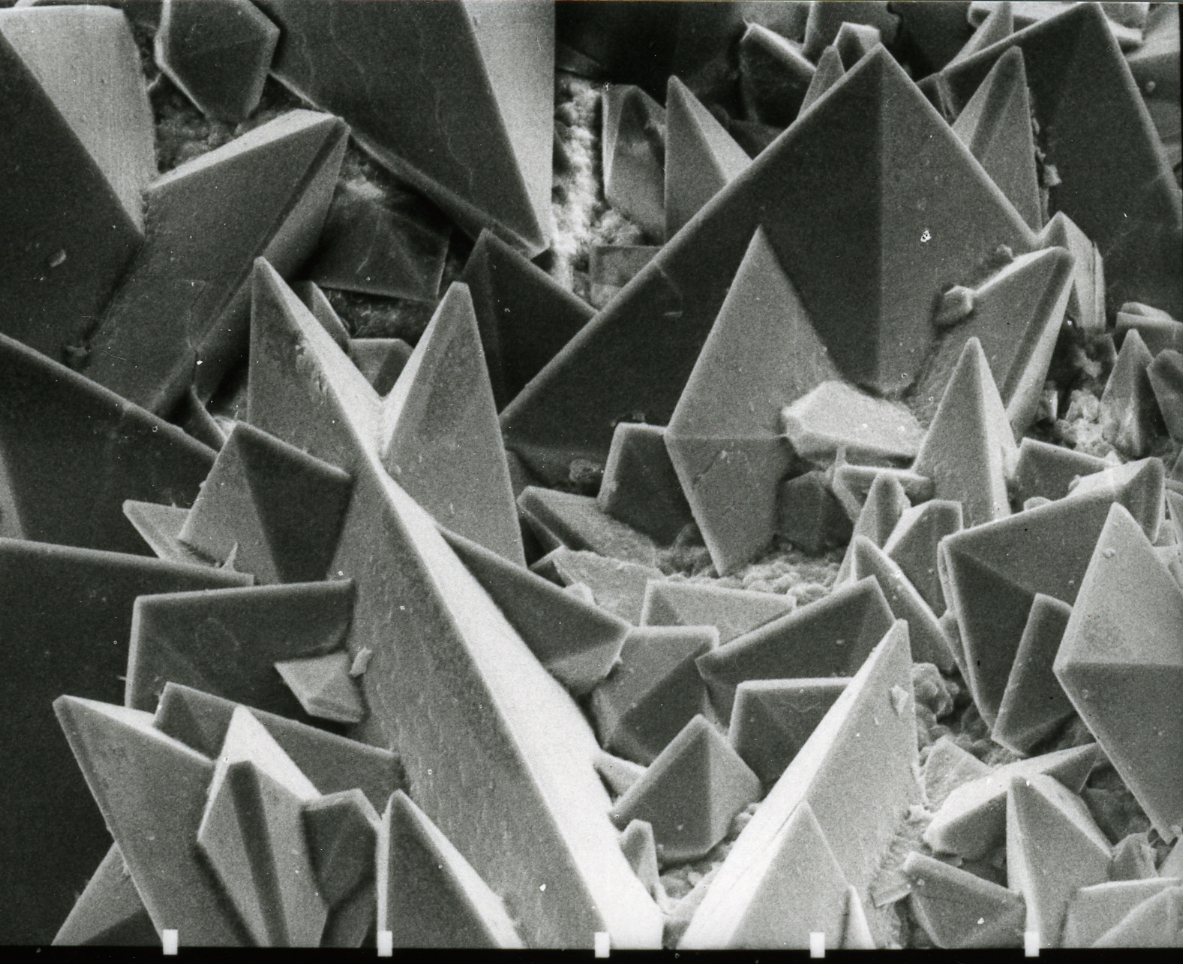|
Beerstone
Calcium oxalate (in archaic terminology, oxalate of lime) is a calcium salt (chemistry), salt of oxalic acid with the chemical formula . It forms hydrates , where ''n'' varies from 1 to 3. Anhydrous and all hydrated forms are colorless or white. The monohydrate occurs naturally as the mineral whewellite, forming envelope-shaped crystals, known in plants as raphides. The two rarer hydrates are dihydrate , which occurs naturally as the mineral weddellite, and trihydrate , which occurs naturally as the mineral caoxite, are also recognized. Some foods have high quantities of calcium oxalates and can produce sores and numbing on ingestion and may even be fatal. Tribes with diets that depend highly on fruits and vegetables high in calcium oxalate, such as in Pandanus_tectorius#Uses, Micronesia, reduce the level of it by boiling and cooking them. They are a constituent in 76% of human kidney stone disease, kidney stones. Calcium oxalate is also found in beerstone, a scale that forms ... [...More Info...] [...Related Items...] OR: [Wikipedia] [Google] [Baidu] |
Sodium Oxalate
Sodium oxalate, or disodium oxalate, is the sodium salt of oxalic acid with the formula Na2C2O4. It is a white, crystalline, odorless solid, that decomposes above 290 °C. Disodium oxalate can act as a reducing agent, and it may be used as a primary standard for standardizing potassium permanganate (KMnO4) solutions. The mineral form of sodium oxalate is natroxalate. It is only very rarely found and restricted to extremely sodic conditions of ultra-alkaline pegmatites. Preparation Sodium oxalate can be prepared through the neutralization of oxalic acid with sodium hydroxide (NaOH) in a 1:2 acid-to-base molar ratio. Evaporation yields the anhydrous oxalateH. W. Foote and John E. Vance (1933), "The system; sodium iodate, sodium oxalate, water". ''American Journal of Science'', series 5, volume 26, issue 151, pages 16-18. that can be thoroughly dried by heating to between 200 and 250 °C. Half-neutralization can be accomplished with NaOH in a 1:1 ratio which produces NaHC2O4 ... [...More Info...] [...Related Items...] OR: [Wikipedia] [Google] [Baidu] |
Raphide
Raphides (pronounced /ˈræfɪˌdiz/, singular raphide /ˈreɪfʌɪd/ or raphis) are needle-shaped crystals of calcium oxalate monohydrate (prismatic monoclinic crystals) or calcium carbonate as aragonite ( dipyramidal orthorhombic crystals), found in more than 200 families of plants. Both ends are needle-like, but raphides tend to be blunt at one end and sharp at the other. Calcium oxalate in plants Many plants accumulate calcium oxalate crystals in response to surplus calcium, which is found throughout the natural environment. The crystals are produced in a variety of shapes. The crystal morphology depends on the taxonomic group of the plant. In one study of over 100 species, it was found that calcium oxalate accounted for 6.3% of plant dry weight. Crystal morphology and the distribution of raphides (in roots or leaves or tubers etc.) is similar in some taxa but different in others leaving possible opportunities for plant key characteristics and systematic identification; m ... [...More Info...] [...Related Items...] OR: [Wikipedia] [Google] [Baidu] |
Araceae
The Araceae are a family of monocotyledonous flowering plants in which flowers are borne on a type of inflorescence called a spadix. The spadix is usually accompanied by, and sometimes partially enclosed in, a spathe (or leaf-like bract). Also known as the arum family, members are often colloquially known as aroids. This family of 114 genera and about 3,750 known species is most diverse in the New World tropics, although also distributed in the Old World tropics and northern temperate regions. Description Within the Araceae, species are often rhizomatous or tuberous; many are epiphytic, creeping lianas or vining plants, and the leaves and tissues of the entire plant nearly always contains irritating calcium oxalate crystals or raphides, in varying degrees. The foliage can vary considerably from species to species. The majority of species produce an inflorescence consisting of a spadix (which some compare to a corn cob, in appearance), which is nearly always surr ... [...More Info...] [...Related Items...] OR: [Wikipedia] [Google] [Baidu] |
Oxalis
''Oxalis'' ( (American English) or (British English)) is a large genus of flowering plants in the wood-sorrel family Oxalidaceae, comprising over 550 species. The genus occurs throughout most of the world, except for the polar areas; species diversity is particularly rich in tropical Brazil, Mexico, and South Africa. Many of the species are known as wood sorrels (sometimes written "woodsorrels" or "wood-sorrels") as they have an acidic taste reminiscent of the sorrel proper ('' Rumex acetosa''), which is only distantly related. Some species are called yellow sorrels or pink sorrels after the color of their flowers instead. Other species are colloquially known as false shamrocks, and some called sourgrasses. For the genus as a whole, the term oxalises is also used. Description and ecology These plants are annual or perennial. The leaves are divided into three to ten or more obovate and top-notched leaflets, arranged palmately with all the leaflets of roughly equal size. The ... [...More Info...] [...Related Items...] OR: [Wikipedia] [Google] [Baidu] |
Turmeric
Turmeric () is a flowering plant, ''Curcuma longa'' (), of the ginger family, Zingiberaceae, the rhizomes of which are used in cooking. The plant is a perennial, rhizomatous, herbaceous plant native to the Indian subcontinent and Southeast Asia that requires temperatures between and a considerable amount of annual rainfall to thrive. Plants are gathered each year for their rhizomes, some for propagation in the following season and some for consumption. The rhizomes are used fresh or boiled in water and dried, after which they are ground into a deep orange-yellow powder commonly used as a coloring and flavoring agent in many Asian cuisines, especially for curries, as well as for dyeing, characteristics imparted by the principal turmeric constituent, curcumin. Turmeric powder has a warm, bitter, black pepper-like flavor and earthy, mustard-like aroma. Curcumin, a bright yellow chemical produced by the turmeric plant, is approved as a food additive by the World Hea ... [...More Info...] [...Related Items...] OR: [Wikipedia] [Google] [Baidu] |
Cinnamon
Cinnamon is a spice obtained from the inner bark of several tree species from the genus '' Cinnamomum''. Cinnamon is used mainly as an aromatic condiment and flavouring additive in a wide variety of cuisines, sweet and savoury dishes, breakfast cereals, snack foods, bagels, teas, and traditional foods. The aroma and flavour of cinnamon derive from its essential oil and principal component, cinnamaldehyde, as well as numerous other constituents including eugenol. Cinnamon is the name for several species of trees and the commercial spice products that some of them produce. All are members of the genus ''Cinnamomum'' in the family Lauraceae. Only a few ''Cinnamomum'' species are grown commercially for spice. '' Cinnamomum verum'' (AKA ''C. zeylanicum''), known as "Ceylon cinnamon" after its origins in Sri Lanka (formerly Ceylon), is considered to be "true cinnamon", but most cinnamon in international commerce is derived from four other species, usually and more correctl ... [...More Info...] [...Related Items...] OR: [Wikipedia] [Google] [Baidu] |
Rhubarb
Rhubarb is the fleshy, edible stalks ( petioles) of species and hybrids (culinary rhubarb) of '' Rheum'' in the family Polygonaceae, which are cooked and used for food. The whole plant – a herbaceous perennial growing from short, thick rhizomes – is also called rhubarb. Historically, different plants have been called "rhubarb" in English. The large, triangular leaves contain high levels of oxalic acid and anthrone glycosides, making them inedible. The small flowers are grouped in large compound leafy greenish-white to rose-red inflorescences. The precise origin of culinary rhubarb is unknown. The species '' Rheum rhabarbarum'' (syn. ''R. undulatum'') and '' R. rhaponticum'' were grown in Europe before the 18th century and used for medicinal purposes. By the early 18th century, these two species and a possible hybrid of unknown origin, ''R.'' × ''hybridum'', were grown as vegetable crops in England and Scandinavia. They readily hybridize, and cul ... [...More Info...] [...Related Items...] OR: [Wikipedia] [Google] [Baidu] |
Sorrel
Sorrel (''Rumex acetosa''), also called common sorrel or garden sorrel, is a perennial herbaceous plant in the family Polygonaceae. Other names for sorrel include spinach dock and narrow-leaved dock ('dock' being a common name for the genus ''Rumex''). Sorrel is native to Eurasia and a common plant in grassland habitats. It is often cultivated as a leaf vegetable or herb. Description Sorrel is a slender herbaceous perennial plant about high, with roots that run deep into the ground, as well as juicy stems and arrow-shaped (sagittate) leaves. The lower leaves are in length with long petioles and a membranous ocrea formed of fused, sheathing stipules. The upper ones are sessile, and frequently become crimson. It has whorled spikes of reddish-green flowers, which bloom in early summer, becoming purplish. The species is dioecious, with stamens and pistils on different plants. Subspecies Several subspecies have been named. Not all are cultivated. * ''Rumex acetosa'' ssp. ' ... [...More Info...] [...Related Items...] OR: [Wikipedia] [Google] [Baidu] |
Dieffenbachia
''Dieffenbachia'' , commonly known as dumb cane or leopard lily, is a genus of tropical flowering plants in the family Araceae. It is native to the New World Tropics from Mexico and the West Indies south to Argentina. Some species are widely cultivated as ornamental plants, especially as houseplants, and have become naturalized on a few tropical islands. ''Dieffenbachia'' is a perennial herbaceous plant with straight stem, simple and alternate leaves containing white spots and flecks, making it attractive as indoor foliage. Species in this genus are popular as houseplants because of their tolerance of shade. The English names, dumb cane and mother-in-law's tongue (also used for '' Sansevieria'' species) refer to the poisoning effect of raphides, which can cause temporary inability to speak. ''Dieffenbachia'' was named by Heinrich Wilhelm Schott, director of the Botanical Gardens in Vienna, to honor his head gardener Joseph Dieffenbach (1796–1863). Species The World Checkli ... [...More Info...] [...Related Items...] OR: [Wikipedia] [Google] [Baidu] |
Poison
Poison is a chemical substance that has a detrimental effect to life. The term is used in a wide range of scientific fields and industries, where it is often specifically defined. It may also be applied colloquially or figuratively, with a broad sense. Whether something is considered a poison may change depending on the amount, the circumstances, and what living things are present. Poisoning could be accidental or deliberate, and if the cause can be identified there may be ways to neutralise the effects or minimise the symptoms. In biology, a poison is a chemical substance causing death, injury or harm to organisms or their parts. In medicine, poisons are a kind of toxin that are delivered passively, not actively. In industry the term may be negative, something to be removed to make a thing safe, or positive, an agent to limit unwanted pests. In ecological terms, poisons introduced into the environment can later cause unwanted effects elsewhere, or in other parts of the fo ... [...More Info...] [...Related Items...] OR: [Wikipedia] [Google] [Baidu] |
Brewery
A brewery or brewing company is a business that makes and sells beer. The place at which beer is commercially made is either called a brewery or a beerhouse, where distinct sets of brewing equipment are called plant. The commercial brewing of beer has taken place since at least 2500 BC; in ancient Mesopotamia, brewers derived social sanction and divine protection from the goddess Ninkasi. Brewing was initially a cottage industry, with production taking place at home; by the ninth century, monasteries and farms would produce beer on a larger scale, selling the excess; and by the eleventh and twelfth centuries larger, dedicated breweries with eight to ten workers were being built. The diversity of size in breweries is matched by the diversity of processes, degrees of automation, and kinds of beer produced in breweries. A brewery is typically divided into distinct sections, with each section reserved for one part of the brewing process. History Beer may have been known in Neo ... [...More Info...] [...Related Items...] OR: [Wikipedia] [Google] [Baidu] |
Kidney Stone Disease
Kidney stone disease, also known as nephrolithiasis or urolithiasis, is a crystallopathy where a solid piece of material (kidney stone) develops in the urinary tract. Kidney stones typically form in the kidney and leave the body in the urine stream. A small stone may pass without causing symptoms. If a stone grows to more than , it can cause blockage of the ureter, resulting in sharp and severe pain in the lower back or abdomen. A stone may also result in blood in the urine, vomiting, or painful urination. About half of people who have had a kidney stone will have another within ten years. Most stones form by a combination of genetics and environmental factors. Risk factors include high urine calcium levels, obesity, certain foods, some medications, calcium supplements, hyperparathyroidism, gout and not drinking enough fluids. Stones form in the kidney when minerals in urine are at high concentration. The diagnosis is usually based on symptoms, urine testing, and medical ... [...More Info...] [...Related Items...] OR: [Wikipedia] [Google] [Baidu] |






_Frambozenrood_bloeiwijze.jpg)


